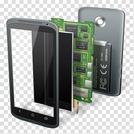
Unrestricted Use
CC BY
Students break apart cell phones to determine what elements are located in cell phones. They then use the elements to determine how the flow of electrons works in the cell phone. Lastly, create designs using legos to practice engineering practices that would be common in engineering.
- Subject:
- Scientific and Engineering Practices
- Material Type:
- Lesson Plan
- Author:
- Sarah McGlothlin
- Date Added:
- 08/03/2020